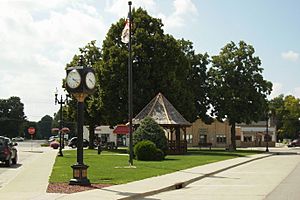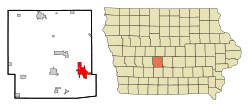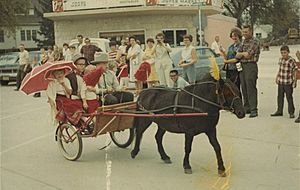Waukee, Iowa facts for kids
Quick facts for kids
Waukee, Iowa
|
|
|---|---|

Triangle Park in Downtown Waukee
|
|
| Motto(s):
"The Key To Good Living"
|
|

Location of Waukee, Iowa
|
|
| Country | |
| State | |
| County | Dallas |
| Area | |
| • Total | 20.96 sq mi (54.29 km2) |
| • Land | 20.92 sq mi (54.17 km2) |
| • Water | 0.04 sq mi (0.12 km2) |
| Elevation | 1,047 ft (319 m) |
| Population
(2020)
|
|
| • Total | 23,940 |
| • Estimate
(2024)
|
31,823 |
| • Density | 1,144.58/sq mi (441.93/km2) |
| Time zone | UTC-6 (Central (CST)) |
| • Summer (DST) | UTC-5 (CDT) |
| ZIP code |
50263
|
| Area code(s) | 515 |
| FIPS code | 19-82695 |
| GNIS feature ID | 2397221 |
Waukee is a city in Dallas County, Iowa, in the United States. In 2020, about 23,940 people lived there. Waukee is part of the larger Des Moines – West Des Moines area. In 2017, Apple Inc. decided to build a very large data center in Waukee. This was a big project costing over a billion dollars!
Contents
The Story of Waukee
Waukee started as a town in 1869. People think it got its name from The Milwaukee Railroad. Waukee officially became a city on December 23, 1878.
Waukee's Location and Climate
Waukee covers about 12.99 square miles (33.64 square kilometers). Most of this area is land. The city is known for its Waukee Stadium.
Weather in Waukee
Waukee has a humid continental climate. This means it has big changes in temperature throughout the year. Summers are warm to hot and often humid. Winters are cold, and sometimes very cold.
Learning in Waukee
The Waukee Community School District is growing very fast. It is the fastest-growing school district in Iowa. More than 2,200 staff members work there. They teach over 13,600 students from preschool to twelfth grade.
The schools serve students from Waukee, Clive, Urbandale, and West Des Moines. Students from other nearby towns can also attend. The district covers about 55 square miles.
Waukee currently has:
- Ten elementary schools
- Two middle schools for grades 6 and 7
- Two middle schools for grades 8 and 9
- Waukee High School
- Waukee Northwest High School
The Vincent Meyer Learning Center is also part of the district. Waukee Northwest High School opened in 2021. It is the district's second high school. The Waukee Warriors sports teams got their name in a funny way. The Norwalk Warriors had to give them jerseys because Waukee didn't have any!
Who Lives in Waukee?
| Historical population | |||
|---|---|---|---|
| Census | Pop. | %± | |
| 1880 | 245 | — | |
| 1890 | 240 | −2.0% | |
| 1900 | 292 | 21.7% | |
| 1910 | 340 | 16.4% | |
| 1920 | 375 | 10.3% | |
| 1930 | 445 | 18.7% | |
| 1940 | 473 | 6.3% | |
| 1950 | 501 | 5.9% | |
| 1960 | 687 | 37.1% | |
| 1970 | 1,577 | 129.5% | |
| 1980 | 2,227 | 41.2% | |
| 1990 | 2,512 | 12.8% | |
| 2000 | 5,126 | 104.1% | |
| 2010 | 13,790 | 169.0% | |
| 2020 | 23,940 | 73.6% | |
| U.S. Decennial Census | |||
Waukee's Population in 2020
In 2020, the city of Waukee had 23,940 people. There were 9,107 households, which are groups of people living together. About 6,208 of these were families.
Most people in Waukee are White (83.1%). Other groups include Black or African American (3.7%), Asian (5.3%), and Native American (0.3%). About 6.0% of people were from two or more races. People of Hispanic or Latino background made up 5.2% of the population.
The average age in Waukee was 33.9 years. About 31.0% of the people were under 20 years old. Also, 11.1% were 65 years old or older. Slightly more than half of the residents (51.5%) were female, and 48.5% were male.
Getting Around Waukee
HIRTA offers a special kind of bus service in Waukee. You can call them to pick you up. However, Waukee is the biggest city in Iowa without regular bus routes. The city of Clive, which is close by, has a bus service that is about half a mile from Waukee.
Famous People from Waukee
Many interesting people have connections to Waukee:
- Paul Gregory — A producer for movies, TV, and stage shows.
- Joey Jordison — The former drummer for the band Slipknot.
- Jake Knott — A former football player for Iowa State and the Philadelphia Eagles.
- Talia Leman — The CEO and a founder of RandomKid. This group helps young people do good things.
- Hal Manders — A relief pitcher in Major League Baseball. He was born in Waukee.
- Anthony Nelson — A former football player for Iowa and a current linebacker for the Tampa Bay Buccaneers.
- Ken Smith — A famous landscape architect who was born in Waukee.
See also
 In Spanish: Waukee (Iowa) para niños
In Spanish: Waukee (Iowa) para niños


